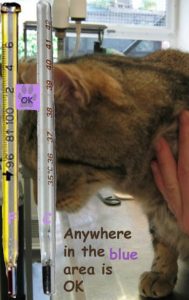Why Is My Dog Or Cat Running A Fever, Or Why is It Cold?
Ron Hines DVM PhD
 See What Normal Blood & Urine Values Are
See What Normal Blood & Urine Values Are
 Causes Of Most Abnormal Blood & Urine Tests
Causes Of Most Abnormal Blood & Urine Tests
 Ear And Other Non-contact Thermometers Are Not Accurate In Your Dog Or Cat. Read here & here
Ear And Other Non-contact Thermometers Are Not Accurate In Your Dog Or Cat. Read here & here
Up =  Hyperthermia = Pyrexia = Fever
Hyperthermia = Pyrexia = Fever
Low =  Hypothermia
Hypothermia
Many dogs and cats run a bit hot from anxiety and excitement when visiting their local veterinarians.
Your dog or cat has a normal body temperature that is a bit higher than yours or mine. Most veterinarians consider a rectal temperature of over 102.5 F/39.2 C to be abnormal in a dog or in a cat. But other factors come into play in determining if your pet really has a fever. Veterinarians learn the significance of those factors through their years of experience. If you are using a digital thermometer on your pet at home, such as a Vick’s ComfortFlex™, your pet’s armpit temperature will be about 2.5 F / 1.4 C lower than its rectal temperature would be if you use the same device. The closer you are to the pet’s body surface, the lower the temperature reading will be. The somewhat higher temperature deep within the body of your pet is called its core body temperature. (read here)
When a fever exists your pet’s body temperature has been set higher by thermoregulators in a portion of its brain, the hypothalamus. That could be due to an infection, toxins, stress and anxiety, inflammation, certain cancers, autoimmune diseases or certain drugs. Although not considered fever or regulated by the brain, high body temperature/ hyperthermia can also be the result of a hot environment – particularly when humidity is high and exertion is substantial. In those situations dogs and cats with flat faces or overweight issues are likely to be the most susceptible. It is normal for dogs engaged in strenuous activities and sports to have body temperatures slightly above normal. That occurs even on cold days. (read here)
The reverse is true when your pet’s core body temperature is subnormal. When those same thermoregulator sensors detect that your pet is too cold, they direct its body to increase heat production through increased metabolism and shivering. At the same time they re-rout circulation to reduce heat loss. When those sensors determine that your pet is too hot, they stimulate panting to dissipate heat and reverse the other processes I mentioned.
Dogs, cats and people cannot tolerate temperature over 107 F/ 41.6 C for long. Things like DIC (= disseminated intravascular coagulation), internal bleeding and serious damage to the brain (cerebral edema), destructive heart beat irregularities (arrhythmias), heart muscle, liver and intestinal lining damage soon occur. (read here) These pet’s bodies quickly becomes too acidic (metabolic acidosis) as well. When body temperature remains over 104 F/ 40 C for extended periods it will cause severe dehydration in your cat or dog.
Your veterinarian might be less concerned about a modestly elevated temperature reading if your dog or cat is emotional, fearful or tense. He/she might take note that it arrived for its appointment after a long car ride on a hot, humid summer’s day. Glancing at your pet’s records, your vet might notice that it had an elevated temperature at prior appointments and take note of that. A lot of pets “run hot” at animal hospitals. The opposite would be true as well. Your veterinarian might be more concerned if your dog is a large calm breed – particularly if there is other evidence during the exam that it might have a health issue.
Sometimes pets with a moderately elevated body temperatures will be given antibiotics. Many of my clients have been adamant that their pet receive a “shot of something”. Vets, being an agreeable lot, tend to oblige their clients wishes. Besides, we might lose a client to a vet clinic down the road. But the fact that your pet’s temperature went down when it got home is really not enough proof that a bacterial or viral infection was the underlying problem. Feeling your pet’s nose is not a good way to tell if it is running a fever – any more than feeling your nose tells you very much about your health.
Dogs with elevated body temperature usually do breathe faster. But many other things, such as excitement and pain cause that too. A glass (or modern digital) rectal thermometer, left up your dog or cat’s anus for up to 2 minutes (or at least until the fluid in older thermometers ceases rising) is the best way to obtain your pet’s temperature (its core body temperature). Dab some margarine on the tip to allow it to be passed easily. Thermometers that measure at the ear, under the arm (axillary area) or in the toe web always give a lower reading than a rectal thermometer. They are of little value. Always keep the thermometer within your grasp while in use.
As I mentioned several times earlier, it is quite common for pets at the animal hospital to run up to ~ 0.6 degree F/ 0.3 C too hot. That is due to the car ride there, excitement and agitation. Many pets internalize those fears. So, the best thing for you to do is to confirm your pet’s body temperature at home while it is relaxed.
Moderate fever is not all bad. God created it for a purpose. It is a part of the natural “acute-phase” response to infections and often plays a positive role in overcoming infections. (read here) Many viruses have difficulty multiplying at higher body temperatures. One successful treatment for herpes infections in puppies is said to be to keep them a bit warmer than they would normally be. (read here)
A 2018 review of the common causes of fever in cats found that infectious diseases were the most common reason cats had temperatures over 102.6 F/ 39.2 C (38.7%). The most common infectious disease causing persistent elevated temperature in cats was FIP. After that came cat fight infections (i.e. cellulitis/abscesses), then ear infections (otitis), then infections in the chest (pyothorax), then urinary tract and kidney infections, then a certain flea-transmitted Mycoplasma with far too many names: (=Mycoplasma felis aka hemotropic Mycoplasma aka haemobartonella aka feline infectious anemia aka Mycoplasma haemofelis). Chronic inflammation in various locations in the bodies of cats accounted for 17.9%. Cancer accounted for 12.3%. A different 2020 study decided that blood infections carried by fleas are currently one of the most common causes of fever in cats – a good reason not to let your cat roam unattended out of doors. (read here) Your veterinarian has access to PCR tests to detect these flea-borne blood infections. Similar fevers sometimes occur in dogs infected with babesia and the other blood parasites transmitted by ticks and fleas. Cats with weakened immune systems due to feline leukemia infection are also at greater risk of fever.
Less Common Causes Of Fever
Inborn genetic defects such as familial Shar-Pei fever can also be responsible for fever. The defect has been reported in several wrinkly skinned breeds of dogs. (read here & here) Consuming an overdose of certain owners’ antidepressant medications (MAOIs), medicinal stimulants like amphetamine, or even household foods like chocolate can cause your pet to run a substantial fever. A transient elevated body temperature is a common side effect of leptospirosis vaccinations in dogs. Several antibiotics (e.g. tetracycline) as well as levamisole can also elevate body temperature in dogs and cats.
Heat Stroke
Heat stroke is a somewhat different issue. High air temperature, high humidity, confined surroundings and pet agitation can all contribute to heat stroke. Because dogs and cats have normal body temperatures a degree or two higher than us humans, all things being equal, heat stroke probably would occur in them at a bit higher temperature than it does in us. However, how we often confine our pets, makes up for that difference. Besides that, lack of whole-body sweating, short-nosed (brachiocephalic) dogs and cats and long-coated and arctic breeds have considerably added risk. The substantial heat generated by active muscles adds to the problem.
Aspirin will not bring this type of hyperthermia down. It will just make the situation worse. For a start, get your dog or cat to a shaded, cooler area. Then sponge the pet down with about 60 F / 16C water. That is water cool to the touch. If available, a drop of liquid dish detergent helps water penetrate to the skin. Avoid getting liquid into your pet’s eyes or mouth and be careful not to get bitten or clawed. Continue until your pet is alert enough to lap water or until it begins to shiver. Much of this is best done in your automobile by a second person with the AC set on medium high while the driver is on the way to your nearest veterinary hospital.
Cancer
Another cause of unexplained fever, particularly in older pets, can be a cancer whose location has not yet been located. Some types of tumors encourage the release of cytokines that cause fever as they move through your pet’s blood stream. (read here)
discospondylitis
The spaces between your dog’s vertebra can harbor persistent bacteria, often staph but even fungal infections. These are usually organisms that have moved from other locations in the pet’s body. The problem is called discospondylitis. Chronic fever can be one of its first signs. discospondylitis is most commonly seen in the larger breeds of dogs. The initial infection might have been in its urinary tract, prostate or blood stream, or the bacteria might have been carried into the dog’s body through a burrowing grass seed (grass awns). Cats are occasionally affected by grass awns as well (read here). Another underlying cause of discospondylitis in dogs is infection with Brucella canis.
Immune-Mediated Anemia
When dogs are found to have autoimmune disorders some of them run fevers, particularly when accompanied by anemia. In most cases those dogs will also be ANA or Coombs Test positive.
Fevers Of Unknown Origin (FUO)
There are occasions when your veterinarian will not be able to immediately determine the cause of your dog or cat‘s fever. Those are called fevers of unknown origin or FUOs. Some of these cases in dogs and cats are probably difficult-to-diagnose infections – things like endocarditis of the heat, kidney infections (pyelonephritis) or prostate infections. An abnormally high white blood cell count might draw your veterinarian’s attention to those causes and to supplemental tests.
Malignant Hyperthermia
Malignant hyperthermia is a sudden increase in your pet’s body temperature triggered by exposure to a drug or other agent. Often it is an anesthetic drug (read here). But it can also be things like brewery waste (read here), or an inherited tendency (read here) and probably many more causes as yet undiscovered.
Eclampsia “Milk Fever”
Pet eclampsia is not the same thing as the pre-eclampsia that Wikipedia redirects you to. They are very different. The eclampsia that veterinarians see is considerably more common in dogs than in cats. During delivery/birthing or in the period shortly before or thereafter, some mother dogs and an occasional cat have problems mobilizing their body’s calcium reserves. In that situation, they can develop a condition called “milk fever” (aka eclampsia, pregnancy tetany, post parturient or postpartum hypocalcemia). That occurs when their parathyroid glands are unable to free bone calcium reserves from their bones fast enough to maintain critical calcium levels in their blood. That can lead to weakness, muscle cramping and even seizures. Many of these pets run fevers.(read here).
Heartworm Treatment
When dogs with substantial adult heartworm numbers are treated with the approved arsenic-containing drug, melarsomine, dead heartworms disintegrate in their circulatory system and lungs. In response to the dying heartworms, it is common for these dogs to run fevers during that period.
Hyperthyroidism In Cats
Some cats with hyperthyroidism are said to run low fevers. But fever can also be a side effect of the methimazole often used to treat them.
Feline Infectious Peritonitis, FIP
FIP is probably the most common cause of lingering fever in cats that are not showing other identifiable causes. In the early stages of this disease caused by the mutation of the the common coronavirus of cats, the only signs are decreased energy level, increased blood globulin level and fever. Experimentally, those cats also tend to have very low blood lymphocyte counts. (read here)
Health Problems That Might Cause Your Dog Or Cat To Have Abnormally Low Body Temperature (Hypothermia)
Your pet’s body temperature will eventually drop in all situations that are grave. When that occurs it is often a sign of terminal exhaustion. Veterinarians always consider it a very worrisome sign – unless perhaps it can be tied to exposure to low-temperature surroundings, recent general anesthesia or medications.
Overwhelming Infections
Toxins associated with overwhelming bacterial infections (septicemia), stomach torsions, or intestinal blockages are common causes of abnormally low body temperature. Circulatory shut down from any cause has the same effect.
Sedatives, Narcotics And Medications
All sedative, anesthetic and narcotic medications in animals uniquely sensitive to them or given in too large a dose eventually result in low body temperature. (read here) Uniquely sensitive dogs and cats or overdoses of certain mood altering medications such as amitriptyline given to anxious cats, clomipramine dispensed for anxiety or acepromazine dispensed to alter behavioral issues can also lead to hypothermia. Ingestion of alcohol, low blood sugar/hypoglycemia and insulin overdose can all lower your pet’s body temperature.
Malnutrition
Cats with hepatic lipidosis, starvation in dogs and cats or long-term malnutrition eventually cause of subnormal body temperatures.
Hypothyroidism
Hypothyroidism in dogs can also be the cause of low body temperature. But that alone is not an accurate way to diagnose that thyroid problem.
Late Pregnancy
Just before your dog or cat’s delivery, its body temperature should drop below 100 F (37.8 C). If your dog or cat’s temperature goes above normal near or after delivery call your veterinarian.
Age
The body temperature of puppies and kittens is normally slightly lower than their mother’s. During their infant period, they are very susceptible to dangerous hypothermia. That is because puppies and kittens have greater surface skin area in proportion to their body weight than they will have as adults. That fact allows their body heat to be lost more easily. This problem can be life-threatening. It can be due to maternal factors, the whelping environment or problems within the infant itself. Read more about those problems here.
Complementary Tests:
Since fever or chill in your cat or dog can have almost as many causes as there are named diseases, your veterinarian will be looking closely for indications as to what the underlying cause of the fever or hypothermia might be. That will be based on your vet’s physical examination, your pet’s age, species, breed and the history and lifestyle information you provide. Veterinarians usually begin with the simpler routine tests they can perform at their animal hospital. They look for suspicious values and results. Then when necessary they move on to more sophisticated tests based on those earlier results and suspicions.
DxMe
You are on the Vetspace animal health website
Visiting the products that you see displayed on this website help pay the cost of keeping these articles on the Internet.



